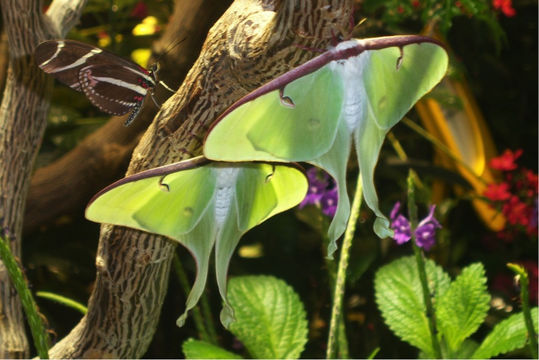Nutrition
The eating habits of the luna moth are quite different
throughout its lifecycle stages. One of the most unique and
interesting facts about this moth is
that the adult does not eat. It has mouthparts, but they are
vestigial which means they are not used for feeding (eol.com). The adult
life stage is very brief, lasting only about seven to ten days,
so although the adults do not eat, they can survive off of the
food they have stored up as a caterpillar.
The luna moth caterpillar is quite the opposite of the
adult. The caterpillars feed mainly on the foliage (leaves) of
birch (Betula), alder (Alnus),
sweetgum (Liquidambar), walnut (Juglans),
and hickory (Carya)
trees.
 These tree species can all be found in deciduous hardwood
forests, which explains why we see this herbivore in large
populations in the eastern United States. The walnut foliage is
a special part of the caterpillar diet and is almost specific to
this organism alone. Walnut leaves contain juglone, which after
careful experimentation, was shown to have negative effects
(loss of midgut lining tissue) on many other species. Actias
luna, however, showed no negative effects to this otherwise
harmful nutrient. Developing a special midgut is one of the
adaptations the luna moth has made
to ensure it has enough food and does not need to worry about
much competition for walnut tree foliage (Thiboldeaux, 1998).
These tree species can all be found in deciduous hardwood
forests, which explains why we see this herbivore in large
populations in the eastern United States. The walnut foliage is
a special part of the caterpillar diet and is almost specific to
this organism alone. Walnut leaves contain juglone, which after
careful experimentation, was shown to have negative effects
(loss of midgut lining tissue) on many other species. Actias
luna, however, showed no negative effects to this otherwise
harmful nutrient. Developing a special midgut is one of the
adaptations the luna moth has made
to ensure it has enough food and does not need to worry about
much competition for walnut tree foliage (Thiboldeaux, 1998).
Another interesting adaptation luna moth caterpillars
demonstrate is that their eating habits change depending on
where a population is located. Their use of a host plant for
food and cocoons is more
"specialized at the population or even individual level, rather
than the species as a whole. Foliar allelochemicals in the
trees themselves play a role in this host-plant utilization"
(Wang, et al., 2003). For example, an experiment was conducted
in which Actias luna larva were fed two different types
of foliage. When fed leaves of Liquidambar formosana (walnut), the larva survived and grew at a good, normal, healthy
pace. However, when fed leaves of Cinnamomum camphora
(camphor tree) every single one of the larvae died (Wang, et al., 2003).
Caterpillars of the luna moth are very specialized with what
they eat. Even though the affects of the two types of foliage
were completely different, interestingly enough the water and
nitrogen contents (important nutrients)were extremely similar
(Wang, et al., 2003). The smallest chemical difference can
destroy the luna moth diet, which is why the location
specialized host-plant utilization is so critical. A caterpillar
must be well fed so it can survive its cocoon stage and develop
into an adult moth.
(walnut), the larva survived and grew at a good, normal, healthy
pace. However, when fed leaves of Cinnamomum camphora
(camphor tree) every single one of the larvae died (Wang, et al., 2003).
Caterpillars of the luna moth are very specialized with what
they eat. Even though the affects of the two types of foliage
were completely different, interestingly enough the water and
nitrogen contents (important nutrients)were extremely similar
(Wang, et al., 2003). The smallest chemical difference can
destroy the luna moth diet, which is why the location
specialized host-plant utilization is so critical. A caterpillar
must be well fed so it can survive its cocoon stage and develop
into an adult moth.
To link back to the luna moth Homepage, click
here.
For some interesting facts, click here.
To learn more about luna moth reproduction, click
here.
To view the gallery, click here.